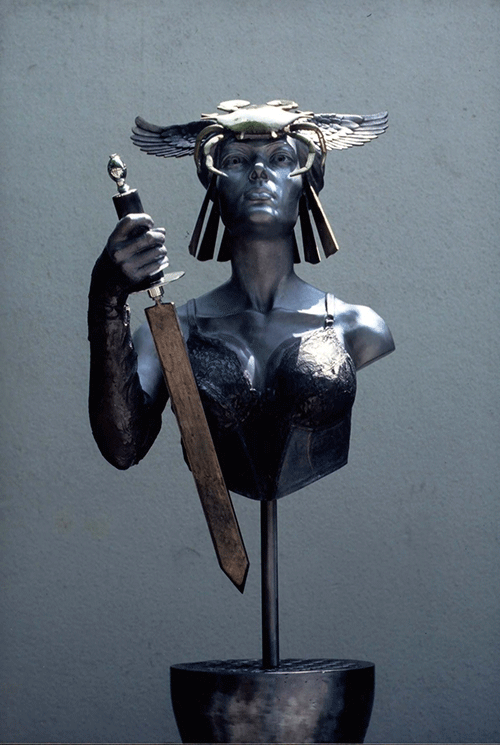Art world of Sculptor Park Kyung-bum
Sculptor Park Kyung-bum plans to have an exhibition of the busts of the noted personalities of the international community as well as of the Korean society on the theme of "Communication and Sharing" and in this effort Park wants to invite the interested ambassadors to take part in the program.
"The world continues to shrink and at the same time it is also expanding in a way," said Park at a recent interview with The Korea Post. "And this makes it necessary to expand the communication and sharing."
The need for communication and sharing is growing among individuals, he said, but it is all the more so among the different countries of the world. Interests are conflicting among them and so is the degree of lack of trust in one another.
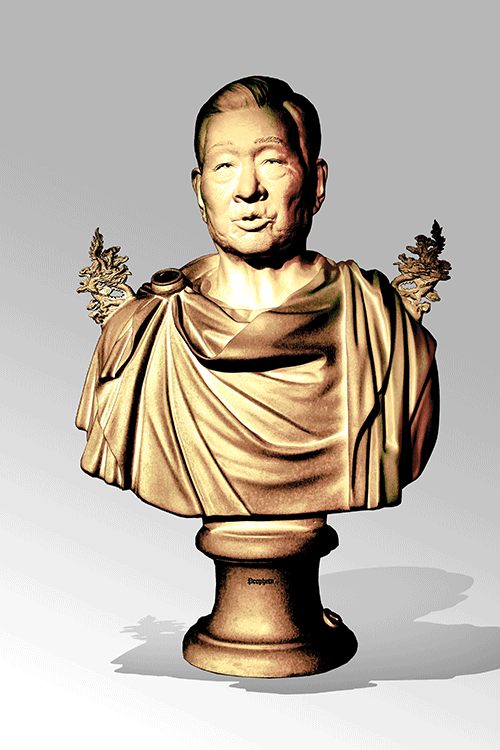
"In front of you, they smile but behind your back they fight with one another in search of hegemony," suggested Park. "Not all of them are so, but some do and the ill-effects of such confrontation and conflict are quite worrisome--where the need and role communication and sharing comes into play."
Art Critic Yoon Jin-sup said, “Sculptor Park Kyung-bum covers through his works the common problems globally faced by the civilized society, including drugs, violence, sex and racial discrimination, and successfully creates works almost to the state of perfection through his outstanding ability of re-creation and setting of circumstances.”
One can easily notice the unique attractiveness of his works through his outstanding ability of expression of the well-proportioned body of a grown-up man and woman, including the well-developed muscular body of man and the slowly emerging image of sex plus a striking contrast between bestiality and humanity. They should be considered an attractiveness and strong point of Sculptor Park.
Critic Yoon says that the latest works of Sculptor Park show the artist’s use of a microscopic approach of the theme through close examination of the object and embodies in his works the key elements of the social problems such as drugs, violence, racial discrimination and sex.Sculptor Park also metaphorically reveals the inverted values and the unisexual customs of today.
Director Chang Kyung-hwa of Arts & Sciences Department of the Gwangju Museum of Art has a rather lengthy view of Sculptor Park, which, however, adequately introduces the artist in various aspects, including Park’s personal aspects, his Buddhist philosophy and aesthetics of untainted spirit. Excerpts follow:
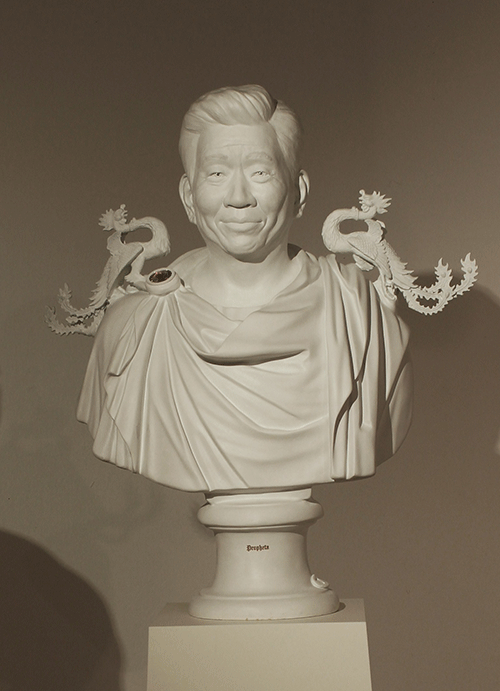
The artist’s mirror:
Young sculptor, Park Kyung-bum, is simply dressed, shaggy, and bashful. His studio is atypically clean for a sculptor, and it shows his meticulous and neat personality.
Art is a mirror that reflects the artist’s character and personality. One can sense artists’ mindset and spirit when viewing their artwork. Park’s calm, neat, meticulous, and artistic character is transferred wholly, and his work shows his character with transparency. Anyone who knows Park can see that through his four solo exhibitions, this has been the link where his art begins and remains.
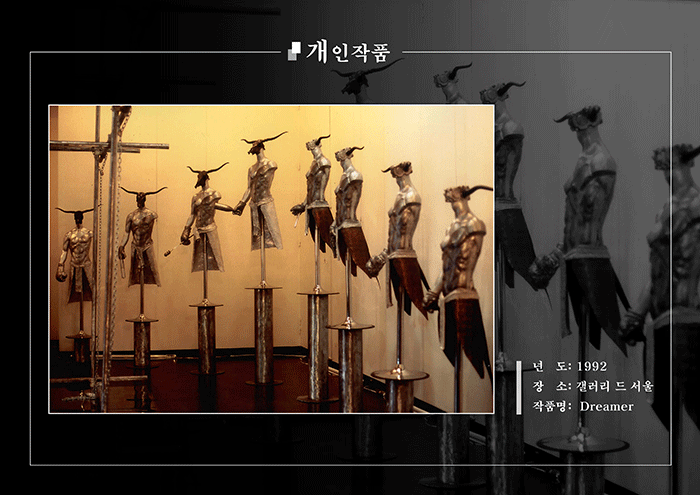
Raising questions:
Park began to be recognized as an up-and-coming, young sculptor in the Korean art market since his second solo exhibition in 1994. He uses realistic depiction of the human body and objects in his sculptures with virtuosity. Paired with faithful and detailed descriptions, the topic and context of Park’s topics work send strong messages and raise questions about human development, and tension is felt from each piece of work.
The characters in Park’s work typically have Caucasian bone structures with heavy and grave facial expressions, as in the characters of ancient Egyptian myths. The garments and ornaments covering the bodies of these characters add to the sculptor’s purpose. Each piece of Park’s work possesses sculptural aesthetics of expansion and movement into the surrounding space.
“Where did man come from, and how does man evolve?” This is the constant question and topic, which Park continues to explore as the subject of his work. He tries to incorporate his philosophical and fundamental questions about the universe and man into his art. He seeks the powerful life force of the genes by following a large wave that flows through time and space and leads to the original DNA.

The characters that appear in his work are similar to the hermaphrodite deities in the movie, Stargate. So what is the message that the artist tries to convey through these characters? Along with the respect for the absolute power, Park hints at his purpose of equating man and god. Park’s work reflects his clear vision, and is brimming with his profound knowledge in anthropology and sociology. He reports numerous obstacles in the continuing development of human civilization, and condemns problems of violence, sex, and drugs, which have become idols and religious endeavors for many in the modern society.
Buddhist philosophy and evolution:
Recently, in his fourth solo exhibition, Park displayed a large-scale sculpture made up of eight human feet, five male and three female, installed to look like somebody walking toward something. One set began in the middle of the wall, and the other set ended up on the wall of the room. Through the human feet, which symbolized the evolving human path, he tried to emphasize the magnificent history and culture of humanity. He recreated the magnificent atmosphere of ancient Buddhist aesthetic, such as that of Ankor Wat, using the color of gold on the feet to show the Buddhist influence. The gold plating on the toenails symbolized the religious sense and mentality of the ancestors, and the artist’s respect for eternity, whether interpreted scientifically or futuristically. This piece is different from his past work in that it reflects Eastern Buddhist philosophy, rather than Western philosophy. This stems from the artist’s thought that Buddhism is the religion that is the most closely connected to the energy of the universe.
Through the showing of Evolution, he reveals that he “tried to put his questions behind [him] and told the story of the progressive path of humanity that tries to maintain its beautiful world. The human race must let go of pride and work with the universe in creating life.”
It seems that Evolution seeks to find the meaning and value of human existence within the universe, and the status quo and hope for humanity in the attempt to verify that “the universe and man exist as one living organism.” Ultimately, the artist hopes to allow for self-esteem and liberate all humanity from god.
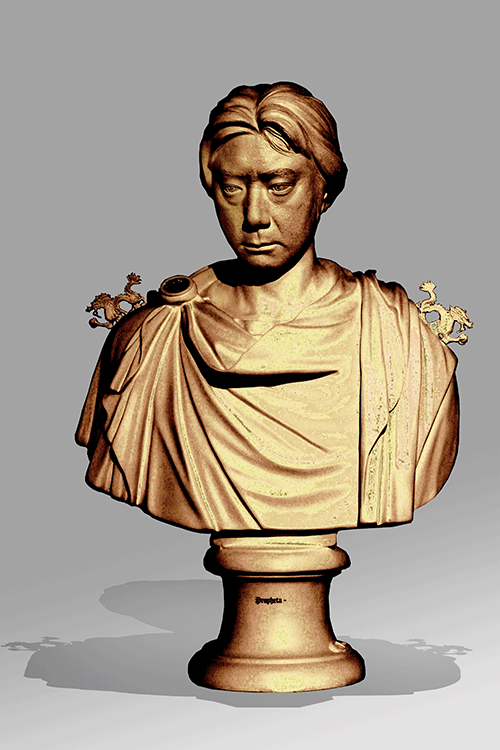
Before considering these philosophical aspects of this piece, the eight gigantic feet in Evolution are visually impressive, and are sufficient to stimulate the viewers’ curiosity. Park Kyung-bum is an artist with keen observation skills and sensibility in reading the code of popularity. The act of making and showing art starts out as a personal expression, but in the end it is shared with the public through exhibition. In this respect, what philosophical values and aesthetic messages will Evolution leave on the minds of the public? The Buddhist philosophy of “One is many, many is one” philosophy might offer answers to these questions.
The aesthetics of an untainted spirit:
Through Park’s large eyes, one can feel a vibrant, creative energy and transparent “Chi.” He is a man that dreams many dreams. He dreams both of dark, cold, and fearful world and of bright heaven. This must be a reflection of his pure and healthy spirit, which can also be sensed through his gaze, his art, his words and actions. His dreams give his great motivation for his art before they are reborn as images. His work makes the viewers wonder, “What makes him create?” Among many factors, three most important ones are his strong will, open world view, and his untainted and vibrant “spirit.” At the base of Park’s world view are his love for humanity and his respect for universal order. His warm love for others has truly liberated him from the pressure and confinements of the modern society.
His purity and energy are carried throughout his work. Thus Park Kyung-bum is attracting much attention as a young artist of this generation, and is loved by many that surround him.
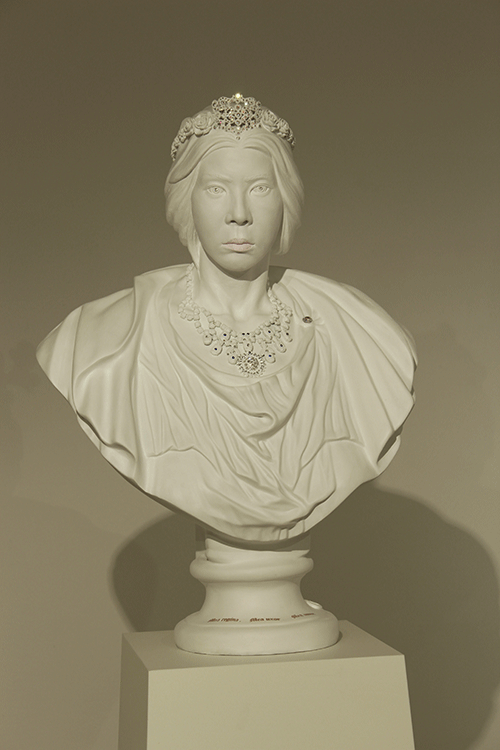
Chosun Ilbo Art Gallery exhibition:
Sculptor Park Kyung-Bum has had many solo and group exhibitions, of which The Korea Post covered one at the prestigious Chosun Ilbo Art Gallery in Seoul in November 2011 on the main theme of ‘Contact with God.’ It was the 10th one-man show. Each time the subject varied according to the works put on display although the main theme, Evolution, remained the same.
“I make it a rule to show all new works at each exhibition,” said Sculptor Park at an interview with The Korea Post at the time. Park put on display a total of 30 sculptural works which he created that year for the exhibition.
Among the works he displayed at the exhibition was the Swarovski picture frame with a thematic object inlaid in the center of the frame with an LED lighting device. It was completed in a three-dimensional form.
Then there was the Body of Woman which stood three and half meters tall.
Another thematic work was Cyborg which superficially looked like an object appearing in a science fiction and a fairy tale - something like a robot. The Cyborg appeared under the theme of ‘Contact with God.’ The Cyborg was a spiritual one but had arms and legs like a robot. It offered a cubic sight at a glance but was a spiritual Cyborg. “I had to rack my brains throughout the rest of this year to create it,” said Park.
He disclosed, “My brain is harnessed to a great extent until the work is completed and I would say I am lost in thinking for 23 hours a day and then use the remaining one hour in creating the work. I would say that all the hours I am awake I use in thinking of the work.”
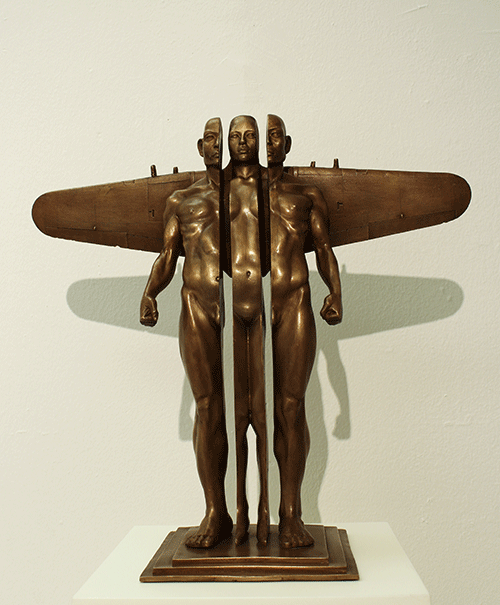
Park said that he consults his wife on many things, including the purpose and reason for the work and how to make it. He said that he endlessly asks his wife questions. Then he said that something casually suggested by his wife sometimes gave him a great help.
In the creation of artistic works in the past, the artist did as he wanted to. Now the time has changed and the broad masses do the work - providing the artist with ideas, suggestions and recommendations.
“After all,” reasoned Sculptor Park, “the artist has a mission to provide the people around him with beauty and affluence.”
Sculptor Park graduated from the Dongguk University College of Fine Art in Seoul in 1991 and then the post-graduate School of Art of the same University earning a master’s degree in art.
List of exhibitions:
Park has solo and group exhibitions on numerous occasions. They include:
11th (the Korea Culture & Arts Foundation-maronie museum etc.)
Myth, tale, allegory (Moran Open-air Museum)
Sudden propose of 100 persons (Gallery Sun)
50th anniversary National Art Exhibition (National Theater)
Lighting Sculpture Exhibition (National Theater)
Independent art exhibition (Hongik University)
Seon (Zen) art exhibition (Seoul Art Center)
2002 FIFA World cup Exhibition (Seoul Art Center)
New progress of 100 persons (Gyeonggi government building)
Existence and Illusion (Gwang-ju Art Museum)
First across symposium (Myeongdong Cathedral)
One-Korea Festival (Uijeong-bu)
Incheon Art Fair (Incheon Center)
Chinese-Korean Sculptor’s Exhibition & Symposium (Xiamen Art Museum)
Thinking of 2007 (Duru art Space)
Sex of Art (Dusan Art Center)
Beijing International Art Fair (Galerie GAIA, Beijing)
The Body in Modern Sculpture-Square Sculpture (Gyungnam Art Museum)
NICAF 10-Zoom in Artists (China/Tienjin)
DAF-Art in Korea (Seoul Art Center)
Group/Invitational Exhibition:
Myth, tale, allegory: Moran Openair Museum
Sudden proposal by 100 Persons: Gallery Sun
The National Theater 50th Anniversary Exhibition: The National Theater of Korea in Seoul
Lighting Sculpture Exhibition: National Theater
Independent Art Exhibition: Hongik University, Seoul
Zen (Sun) Art Exhibition: Dansung Gallery
2002 FIFA Worldcup Exhibition: Seoul Arts Center
New Progress of 100 {persons: Government Building of Gyeonggi Province
Existence and Illusion: Gwangju Art Museum
The 1st Across Symposium: Myeong-dong Cathedral
One Korea Festival: Uijeongbu City, Gyeonggi Province
Incheon Art Fair: Incheon Art Centar]
Chinese-Korean Sculptors’ Exhibition & Symposium: Xiamen Art Museum
Thinking of 2007: Duru Art Space
Sex of Art: Dusan Art Center
Beijing International Art Fair: Galerie GAIA, Beijing
The Body in Modern Sculpture--Square Sculpture:
Gyeongnam Art Museum
'NICAF 10--Zoom in Artists: Tinjin, China
DAF--Art in Korea: Seoul Art Center
The Korea Post Silver Jubilee Anniversary
Exhibition: Lotte Hotel, Seoul, KoreaContact address and numbers:
603-801 Eunpyeong New Town Sangnimmaeul, Jingwan-dong, Eunpyeong-gu, Seoul, Korea
Mobile 010-7395-0078
E-mail indigo1224@hanmail.net k
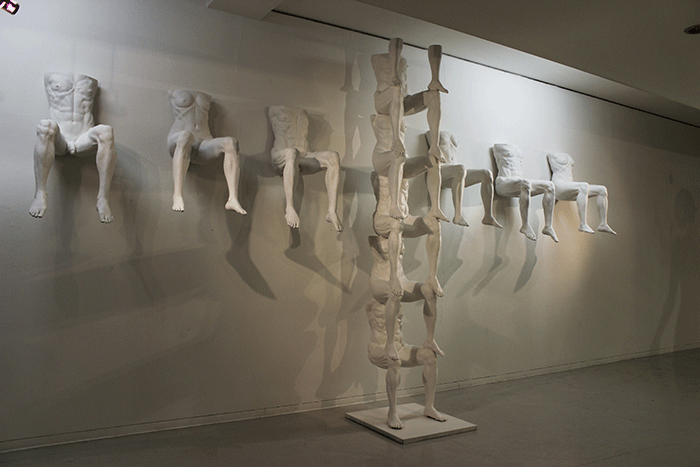
Life-casting of models:
According to Sculptor Park Kyung-bum, life-casting is done in creating the busts of persons for praising their outstanding achievements, celebrations and in memory of deceased persons, and this has been done from long ago. This is a clay work done by the sculptor.
After the clay work is done, the sculptor applies plaster on the clay work and makes a mold. In the mold, the sculptor pours plaster filling it up. It is like making Bungeobbang (fish) cake.
The plaster model thus obtained goes through the delicate process of re-touching by the sculptor to the state of an art work.
Life-casting, according to Wikipedia, is the process of creating a three-dimensional copy of a living human body, through the use of molding and casting techniques.

The most common lifecasts are of torsoes, pregnant bellies, hands, faces, and gentalia and it is possible for an experienced life-casting practitioner to copy any part of the body. Life-casting is usually limited to a section of the body at a time, but full-body lifecasts are achievable too. Compared with other three-dimensional representations of humans, the standout feature of lifecasts is their high level of realism and detail.
A variety of materials can be used for both the molding and casting stages of the life-casting process. For molding, alginate, and plaster bandages are the most popular materials. Less common mold materials are silicones, waxes, gelatins, and plaster. Plaster and gypsum cement are the most commonly used casting materials, but various clays, concretes, plastics and metals are also in common use. Ice, glass, and even chocolate have been used on occasion as casting materials. Work is being done with imaging technology to map the skin's surface which may enable re-creation of the shape without touching the body. Since the weight of material deforms the body, if only slightly, this new technique may enable even more perfect work, but will not give the skin texture the above-listed materials do.
Life-casting is considered a sculptural art by some, while others think it is more a technical skill and the work of artisans. Critics of life-casting as an art claim that it lacks the talent or creativity that more conventional sculptural disciplines require. This criticism echoes that heard in artistic circles during the late nineteenth and early twentieth centuries relating to photography.
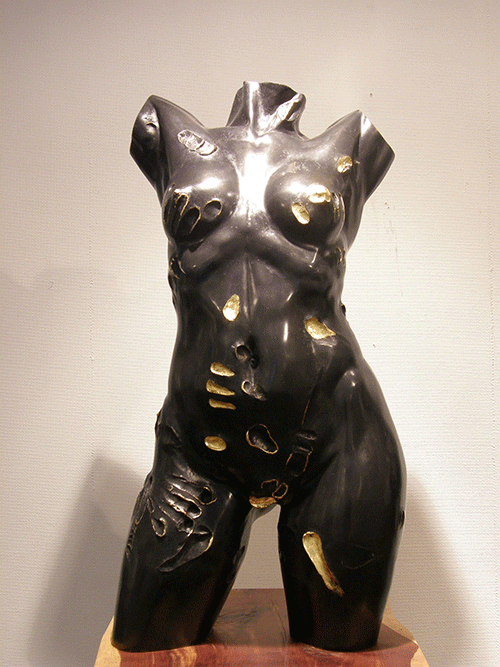
In fact life-casting has been called a three-dimensional type of photography. As with photographs, lifecasts are sometimes manipulated, altered and incorporated with other media.
Lifecasters are united only by the fact that each work starts with a lifecast. Artistic choices begin with choice of model, of pose, and of area of the body shown. Defining the edge is clearly a sculptural act. Probably the most popular alteration is to add paint and various finishes to the surface of the lifecast. Duane Hanson is the best-known contemporary sculptor to use life-casting in his works. He perfectly reproduced the entire body including hair and skintone. His "everyman" works were dressed and posed to look like unexceptional people.
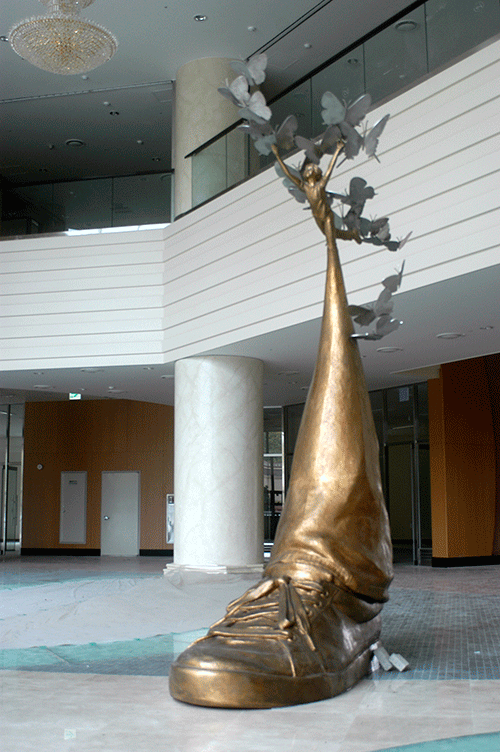
Life-casting allows creation of exact portraits and body reproduction, works which may have artistic and personal value.
Life-casting is regularly practiced in the special effects industry, where it is used in the creation of prosthetics, props, and animatronics, most commonly for film and television. Life-casting also finds medical use in the creation and fitting of prostheses and dentures.
Life-casting has also found a niche market in the creation of personalized dildos, which are the cast replicas of erect penises. Several companies sell life-casting kits designed specifically for this purpose. It is also possible to make molds of the vagina as well, though the process is more complicated.
Pregnant women often choose to have a belly cast of their torso made between the 35th - 38th week of pregnancy to capture their shape.
